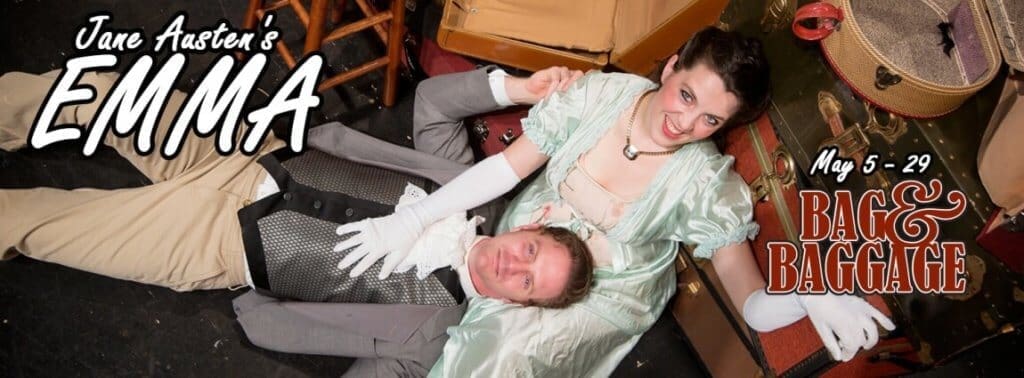- Skip to primary navigation
- Skip to secondary navigation
- Skip to main content
- Skip to primary sidebar
No Notes In The Margins: Cassie Greer’s EMMA Blog
 Knowing I had been asked to write this blog post for our production of “Emma”, and being at an entire loss for where to begin, I picked up the copy of Jane Austen’s novel that I have owned for approximately seventeen years. I was hoping that I had, at some point, underlined a poignant passage or made notes about certain section of the text that I could use as a handy jumping-off point.
Knowing I had been asked to write this blog post for our production of “Emma”, and being at an entire loss for where to begin, I picked up the copy of Jane Austen’s novel that I have owned for approximately seventeen years. I was hoping that I had, at some point, underlined a poignant passage or made notes about certain section of the text that I could use as a handy jumping-off point.
I eagerly paged through…and discovered not a single pen mark.
No underlines, no circles, no smiley faces, no multi-colored notations, nothing.
From my adolescence, I have probably read this book upwards of eight times.
At least eight times and no notes?!
This is, as you may be starting to understand, extremely uncharacteristic of me. But I think that, perhaps, this is the most telling thing about my relationship with this particular piece of Jane Austen’s work: it means that as I read, I simply enjoyed it.
My frequent dips back into the world of Highbury over the course of my growing-up years had been entirely ones of pleasure.
Well. That was unexpected.
What is it about “Emma” that I enjoyed so much? Why did I reach for that novel in particular when I simply wanted a fun, enjoyable read?
While I’m tempted to say that Emma, as a very headstrong, self-centered heroine, makes me feel way better about myself as a person and my own chances for a lifetime of happiness, and perhaps I read and reread her story as a way of wanting to make myself feel good, I think the answer actually lies in Jane Austen’s knack for creating fascinating and compelling characters.
Emma Woodhouse’s world is populated with a colorful range of persons and personalities, all of whom are at once quirky and sympathetic. They are all desperately flawed, navigating their lives and their little society with as much grace as they can muster, to both comic and tragic effect. As a reader, I took a unique joy in seeing these personalities and relationships unfold before my eyes, and even as I knew how it would all inevitably play out, Jane Austen would seduce me again and again with her descriptions and her talent for placing me right in the center of the story, in the heart of the action.
As I revisit this text as an actor, it is very much the same thing – these characters – that makes me so eager to get into the rehearsal room every day. Michael Fry’s script distills all of the people surrounding Emma down to their most potent, memorable parts, and gifts us with the opportunity, as performers, to explore multiple characters within a single text. The theatre, and the performative context Fry gives us, is a giant permission slip for making bold character choices and exploring these residents of Highbury, their thoughts and their relationships, in a physical and bodied way, as we challenge ourselves to penetrate Jane Austen’s imagination and place her characters on stage with as much effervescence as they have in her writing.
The other thing Fry brings to Austen’s story is the frame of five young friends in an attic, rediscovering the story of “Emma” and exploring these characters with each other for the first time. We have characters within characters, and layers of relationships, and tons of stuff to play with and work off of.
As an actor, I am so fortunate to get to do this with some of my closest colleagues and best friends – it is not a stretch to imagine the five of us acting out things together for the fun of it, performing for each other, making each other laugh, and celebrating the opportunity to share and tell stories together.
That is, in fact, more or less what we do in rehearsal every day.
Or when we’re out at the bar.
Or sitting around having dinner together.
Or in the car (spending what sometimes feels like our entire lives) driving to and from Hillsboro.
In working with people whom I trust so implicitly, the work is not only more fun, but we are also able to go further, deeper – pushing ourselves and challenging each other to tell a story that is clear, specific, thoughtful, bodied, nuanced, and simultaneously Jane Austen’s and entirely our own. My excitement about (and investment in) the idea of character comes, I think, not only from my own history with this text, but perhaps even more from watching my colleagues bring their own energy and talents and unique perspectives to the script, themselves dedicated to penetrating the essence of character and story.
We’re in the thick of the process right now – the part where we make choices and messes, and ultimately unique moments of connection. I couldn’t imagine better people to be doing it with, or a story that more appropriately deserves our attention and our commitment to creating characters that delight, disappoint, and ultimately inspire you – just like my adolescent self – to want to hear the story again and again and again…
Cassie Greer
Resident Actor


Reader Interactions